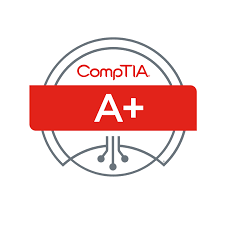Days of Training: 5 Days
Course Description
This 5-day course maps to CompTIA A+ Certification Comprehensive: Exams 220-1201 and 220-1202 which provides the basic knowledge needed to install, configure, and support computer software and implement networking. This includes:
- Applying basic methodical troubleshooting skills as an IT technician
- Identifying motherboard and CPU components, installing or replacing them, and troubleshooting their functions
- Identifying power supply functions and connectors, installing them into a PC, and troubleshooting power issues
- Configuring BIOS/UEFI firmware, identifying and installing RAM, and troubleshooting memory issues
- Comparing internal and external expansion buses on a computer, installing internal cards, and identifying expansion cables and connectors
- Distinguishing between physical storage technologies, installing drives, and troubleshooting storage problems
- Connecting, configuring, and troubleshooting common input-output devices
- Describing common printing technologies, installing and maintaining printers, and troubleshooting printing issues
- Identifying client operating system features, installing Windows and application software, and working with scripts
- Managing and troubleshooting operating systems using built-in administrative tools, such as the Windows Control Panel, Windows Settings, and command-line utilities
- Describing network principles, network devices, and internet connection technologies
- Identifying and categorizing network cables and connectors
- Configuring and troubleshooting issues related to TCP/IP and other network protocols
- Describing common wireless networking standards and encryption methods
- Configuring and troubleshooting problems with Windows resource sharing and network connections
- Identifying and using virtualization technology and cloud computing services
- Identifying types of mobile devices and operating systems, and configuring and troubleshooting mobile devices
- Recognizing common cybersecurity threats and the security controls which are used to reduce risk
- Identifying and using security features built into operating systems, as well as security hardware and software used on workstations and networks
- Securing workstations and mobile devices against security risks, and troubleshooting common security issues such as malware infection
- Applying best practices in IT operations, including policies, documentation, ticketing systems, incident response, and data backups and recovery
This course maps to the CompTIA A+ Certification 220-1201 and 220-1202 certification exams.
Prerequisites
This course assumes that you have basic computer knowledge.
Outline:
Troubleshooting
- Troubleshooting theory
- Safety
- Environmental factors
Motherboards and CPUs
- Motherboards
- CPUs
Computer power supplies
- Power supply connectors
- Power supply installation
- Power supply troubleshooting
Memory
- Read-only memory
- Random-access memory
Computer expansion
- Expansion interfaces
- Expansion card installation
- Connectors and cables
Physical storage
- Disk drives
- RAID storage
- Optical drives
- Other storage methods
Input-output devices
- Input devices
- Display output devices
- Display management
- Other input and output devices
Printers and multi-function print devices
- Printer technologies
- Printer installation and maintenance
- Printer troubleshooting
Operating systems
- Windows versions and features
- Non-Windows operating systems
- Operating system installation and upgrades
- Applications and scripting
Operating system management
- Operating system features and tools
- Control Panel utilities
- Command-line utilities
- Operating system troubleshooting
Network basics
- Classifying networks
- Network devices
- Internet connections
Network cables and connectors
- Twisted-pair connections
- Coaxial connections
- Optical media
Network protocols
- TCP/IP settings
- Transport protocols
- Application protocols
Wireless networking
- Wireless technology
- Wi-Fi standards
Windows networking
- Network shares
- Network connections
- Connection troubleshooting
Virtualization and cloud computing
- Virtualization
- Cloud computing
Mobile devices
- Mobile device types
- Mobile device configuration
- Mobile device troubleshooting
Security principles
- Threats and vulnerabilities
- Security controls
Security technologies
- Operating system security
- Security hardware and software
Securing devices and data
- Workstation security
- Mobile device security
- Security troubleshooting
Securing networks
- SOHO router features
- Network security
Operational procedures
- Professionalism
- IT operations
- Incident response
- Backup and recovery
Certification

You must take Exam 220-1201 (Core 1) and Exam 220-1202 (Core 2) to become certified.
Schedule your exam @ Vue.com/CompTIA

